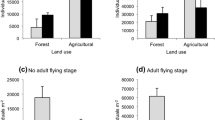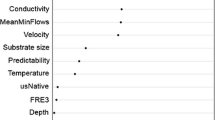Abstract
Environmental heterogeneity can affect the behavior of organisms, but the consequences of patchiness for organismal energetics (e.g., growth, fitness) are not well understood. This study demonstrates that spatial heterogeneity can affect the growth of aquatic stream insects in laboratory streams, and reveals the behavioral mechanisms for these effects. In a 2×2 factorial design, I experimentally manipulated resource distribution (homogeneous vs. patchy, with the same overall resource levels) and current velocity (fast vs. slow) to investigate the direct and interactive effects of these factors on the drift behavior and growth of two mobile stream grazers, the mayflies Baetis bicaudatis and Epeorus deceptivus. B. bicaudatis nymphs grew larger in environments with homogeneously distributed resources than in patchy environments, and both species grew larger in fast than slow current environments. Patterns of drift behavior over the course of the study corresponded to observed differences in growth. Both species grew to larger body size in treatments where they drifted more successfully among substrates (fast-current treatments) and where they entered the drift less frequently (fast current for both species, and homogeneous treatments for B. bicaudatis). Overall, these results demonstrate that patchiness can significantly influence both the behavior of aquatic insects and the size to which these insects grow. In the light of previously published relationships between nymphal mayfly body mass and fecundity, these results suggest that patchiness in streams may have important consequences for mayfly populations.
Similar content being viewed by others
References
Allan JD, Flecker AS (1989) The mating biology of a mass-swarming mayfly. Anim Behav 37:361–371
Behmer DJ, Hawkins CP (1985) Effects of overhead canopy on macroinvertebrate production in a Utah stream. Freshwater Biol 16:287–300
Bohle HW (1978) Relation between food supply, drift and microdistribution of larvae of Baetis rhodani; investigations in a stream model. Arch Hydrobiol 84:500–525
Brittain JE (1982) Biology of mayflies. Annu Rev Entomol 27:119–148
Ciborowski JJH (1983) Influence of current velocity, density, and detritus on drift of two mayfly species (Ephemeroptera). Can J Zool 61:119–125
Clifford HF (1970) Variability of linear measurements throughout the life cycle of the mayfly Leptophlebia cupida (Say) (Ephemeroptera: Leptophlebiidae). Pan-Pac Entomol 46:98–106
Clifford HF (1972) A year's study of the drifting organisms in a brown-water stream of Alberta, Canada. Can J Zool 50:975–983
Corkum LD (1976) A comparative study of behaviour relating to differential drift of two species of mayfly. Ph.D. thesis, University of Toronto, Ontario
Corkum LD, Pointing PJ, Ciborowski JJH (1977) The influence of current velocity and substrate on the distribution and drift of two species of mayflies (Ephemeroptera). Can J Zool 55:1970–1977
Downes BJ, Lake PS, Schreiber ESG (1993) Spatial variation in the distribution of stream invertebrates: implications for patchiness models of community organization. Freshwater Biol 30:119–132
Elliot JM (1967) The life histories and drifting of the Plecoptera and Ephemeroptera in a Dartmoor stream. J Anim Ecol 36:343–362
Feldmeth CR (1970) The respiratory energetics of two species of stream caddis fly larvae in relation to water flow. Comp Biochem Physiol 32:193–202
Feminella JW, Power ME, Resh VH (1989) Periphyton responses to invertebrate grazing and riparian canopy in three northern California coastal streams. Freshwater Biol 22:445–457
Flecker AS, Allan JD, McClintock NL (1988) Male body size and mating success in swarms of the mayfly Epeorus longimanus. Holarct Ecol 11:280–285
Hansen RA, Hart DD, Merz RA (1991) Flow mediates predatorprey interactions between triclad flatworms and larval black flies. Oikos 60:187–196
Hart DD (1981) Foraging and resource patchiness: field experiments with a grazing stream insect. Oikos 37:46–52
Hart DD (1992) Community organization in streams: the importance of species interactions, physical factors and chance. Oecologia 91:220–228
Heise BA (1992) Sensitivity of mayfly nymphs to red light: implications for behavioral ecology. Freshwater Biol 28:331–336
Hemphill N (1991) Disturbance and variation in competition between two stream insects. Ecology 72:864–872
Hershey AE, Pastor J, Peterson BJ, Kling GW (1993) Stable isotopes resolve the drift paradox for Baetis mayflies in an arctic river. Ecology 74:2315–2325
Hildebrand SG (1974) The relation of drift to benthos density and food level in an artificial stream. Limnol Oceanogr 19:951–957
Hinterleitner-Anderson D, Hershey AE, Schuldt JA (1992) The effects of river fertilization on mayfly (Baetis sp.) drift patterns and population density in an arctic river. Hydrobiologia 240:247–258
Horn HS (1966) Measurement of “overlap” in comparative ecological studies. Am Nat 100:419–424
Hughes DA (1966) On the dorsal light response in a mayfly nymph. Anim Behav 14:13–16
Hynes HBN (1970) The ecology of running waters. University of Toronto Press, Toronto
Jones JG (1978) Spatial variation in epilithic algae in a stony stream (Wilfin Beck) with particular reference to Cocconeis placentula. Freshwater Biol 8:539–546
Keller A (1975) The drift and its ecological significance. Experimental investigations on Ecdyonurus venosus (Fabr.) in a stream model. Schweiz Z Hydrol 37:294–331
Kohler SL (1984) Search mechanism of a stream grazer in patchy environments: the role of food abundance. Oecologia 62:209–218
Kohler SL (1985) Identification of stream drift mechanisms: an experimental and observational approach. Ecology 66:1749–1761
Krebs JR (1978) Optimal foraging: decision rules for predators. In: Krebs JR, Davies NB (eds) Behavioural ecology: an evolutionary approach. Blackwell, Oxford, pp 23–63
Mayer MS, Likens GE (1987) The importance of algae in a shaded headwater stream as food for an abundant caddisfly. J N Am Benthol Soc 6:262–269
Minshall GW, Peterson RC (1985) Towards a theory of macroinvertebrate community structure in streams. Arch Hydrobiol 104:49–76
Minshall GW, Winger PV (1968) The effect of reduction in stream flow in invertebrate drift. Ecology 49:580–582
Morse DH, Fritz RH (1987) The consequences of foraging for reproductive success. In: Kamil AC, Krebs JR, Pulliam HR (eds) Foraging theory. Plenum, New York, pp 443–455
Peckarsky BL (1985) Do predaceous stoneflies and siltation affect the structure of stream insect communities colonizing enclosures? Can J Zool 63:1519–1530
Peckarsky BL (1991) Habitat selection by stream-dwelling predatory stoneflies. Can J Fish Aquat Sci 48:1069–1076
Peckarsky BL, Dodson SI (1980) Do stonefly predators influence benthic distributions in streams? Ecology 61:1275–1282
Peckarsky BL, Horn SC, Statzner B (1990) Stonefly predation along a hydraulic gradient: a field test of the harsh-benign hypothesis. Freshwater Biol 24:181–191
Peckarsky BL, Cowan CA, Penton MA, Anderson C (1993) Sublethal consequences of stream-dwelling predatory stoneflies on mayfly growth and fecundity. Ecology 74:1836–1846
Pierotti R, Annett C (1987) Reproductive consequences of dietary specialization and switching in an ecological generalist. In: Kamil AC, Krebs JR, Pulliam HR (eds) Foraging theory. Plenum, New York, pp 417–422
Ploskey GR, Brown AV (1980) Downstream drfit of the mayfly Baetis flavistriga as a passive phenomenon. Am Midl Nat 104:405–409
Poff NL, Ward JV (1992) Heterogeneous currents and algal resources mediate in situ foraging activity of a mobile stream grazer. Oikos 65:465–478
Poff NL, Voelz NJ, Ward JV, Lee RE (1990) Algal colonization under four experimentally-controlled current regimes in a high mountain stream. J N Am Benthol Soc 9:303–318
Poff NL, DeCino RD, Ward JV (1991) Size-dependent drift responses of mayflies to experimental hydrologic variation: active predator avoidance or passive hydrodynamic displacement? Oecologia 88:577–586
Power ME, Matthews WJ (1983) Algae-grazing minnows (Campostoma anomalum), piscivorous bass (Micropterus spp.), and the distribution of attached algae in a small prairie-margin stream. Oecologia 60:328–332
Power ME, Matthews WJ, Stewart AJ (1985) Grazing minnows, piscivorous bass, and stream algae: dynamics of a strong interaction. Ecology 66:1448–1456
Richards C, Minshall GW (1988) The influence of periphyton abundance on Baetis tricaudatis distribution and colonization in a small stream. J N Am Benthol Soc 7:77–86
Shorrocks B, Swingland IR (eds) (1990) Living in a patchy environment. Oxford University Press, New York
Sibly RM, Smith RH (eds) (1984) Behavioural ecology: ecological consequences of adaptive behavior (25th symposium of the British Ecological Society). Blackwell, Oxford
Statzner B, Gore JA, Resh VH (1988) Hydraulic stream ecology: observed patterns and potential applications. J N Am Benthol Soc 7:307–360
Stephens DW, Krebs JR (1986) Foraging theory. Princeton University Press, Princeton
Stewart KW, Szczytko SW (1983) Drift of Ephemeroptera and Plecoptera in two Colorado rivers. Freshwater Invertebr Biol 2:117–131
Underwood AJ (1981) Techniques of analysis of variance in experimental marine biology and ecology. Oceanogr Mar Biol Annu Rev 19:513–605
Wallace JB, Gurtz ME (1986) Response of Baetis mayflies (Ephemeroptera) to catchment logging. Am Midl Nat 115:25–41
Walton OE (1980) Active entry of stream benthic macroinvetebrates into the water column. Hydrobiologia 74:129–139
Werner EE, Gilliam JF, Hall DJ, Mittelbach GG (1983) An experimental test of the effects of predation risk on habitat use by fish. Ecology 64:1540–1548
Wiley MJ, Kohler SL (1980) Positioning change of mayfly nymphs due to behavioral regulation of oxygen consumption. Can J Zool 58:618–622
Wiley MJ, Kohler SL (1984) Behavioral adaptations of aquatic insects. In: Resh VH, Rosenberg DM (eds) The ecology of aquatic insects. Praeger Scientific, New York, pp 101–133
Wilkinson L (1987) SYSTAT (version 5.3): the system for statistics. SYSTAT, Evanston
Wilzbach MA, Cummins KW, Knapp RA (1988) Toward a functional classification of stream invertebrate drift. Verh Int Ver Theor Angew Limnol 23:1244–1254
Author information
Authors and Affiliations
Rights and permissions
About this article
Cite this article
Palmer, T.M. The influence of spatial heterogeneity on the behavior and growth of two herbivorous stream insects. Oecologia 104, 476–486 (1995). https://doi.org/10.1007/BF00341345
Received:
Accepted:
Issue Date:
DOI: https://doi.org/10.1007/BF00341345




